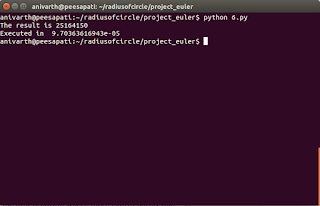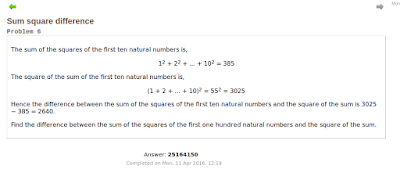Sum square difference
The sum of the squares of the first ten natural numbers is,
Find the difference between the sum of the squares of the first one hundred natural numbers and the square of the sum?
12 + 22 + ... + 102 = 385
The square of the sum of the first ten natural numbers is,
(1 + 2 + ... + 10)2 = 552 = 3025
Hence the difference between the sum of the squares of the first ten
natural numbers and the square of the sum is 3025 − 385 = 2640.Find the difference between the sum of the squares of the first one hundred natural numbers and the square of the sum?
So as usual I will show you the first program which I wrote for this one, and also the improved program so that you can understand it easily.
To be frank both the programs are having approximately the same time of execution for the given set of first hundred numbers. So I had to try for first one million numbers and I found that the improved program was having more run time than that of the first program.
Thus we can say that the first program which I wrote was better than the improved version.
Program
The first program I wrote was:
As you can see it is pretty simple and I think there is no need for explanation.
If you want to download this program then you can download it from Github gist.
The improved version(Even though it took more execution time, as it was the second program I wrote I am calling it improved version) which I told you is as follows:
#http://radiusofcircle.blogspot.com import time #Time at the start of execution start = time.time() #sum of squares of natural numbers sum1 = sum(map(lambda x: x**2, range(1,101))) #square of sum of natural numbers sum2 = sum(range(1,101))**2 #result result = sum2 - sum1 #printing the result print result #Time at the end of execution end = time.time() #printing the execution time print end-start
To understand this program one has to read
In the first sum(
sum1) we have used lambda expression combined with map function to take each and every element in the list and then convert it into its square. Finally using the sum function I have added all the values in the list.
In a similar way we have used the sum function to find the sum of natural numbers from 1 to 100 and stored the value in
sum2.Output
Summary
I think because of using lot of functions in the second program, the execution time is more when compared to the first program where there is(are) barely one function(s) used.
I have not explained the program because the program is well commented. But if you have any doubt or didn't understand anything then please do comment in the comment box below and I will be glad to help you.
Please don't hesitate to comment in the comment box below if I have made any typo or if you want me to add any extra thing in the program.
You can also contact me if you want to.
Thank you. Have a nice day☺️.

